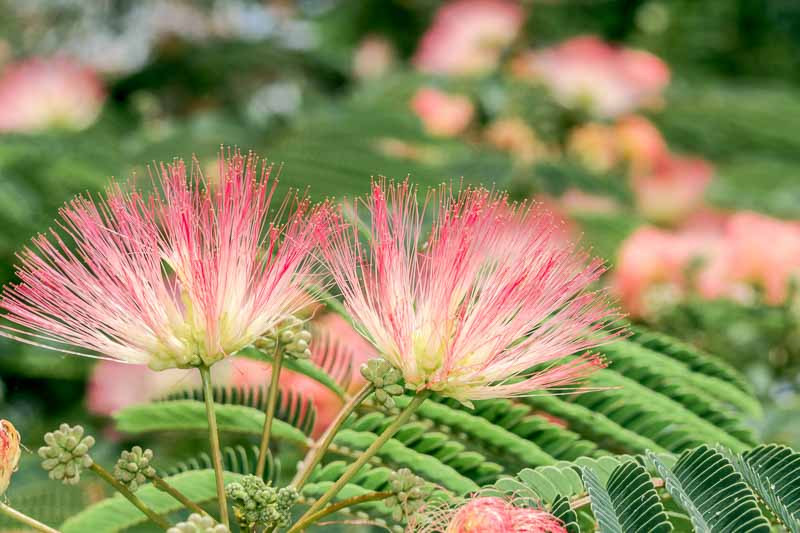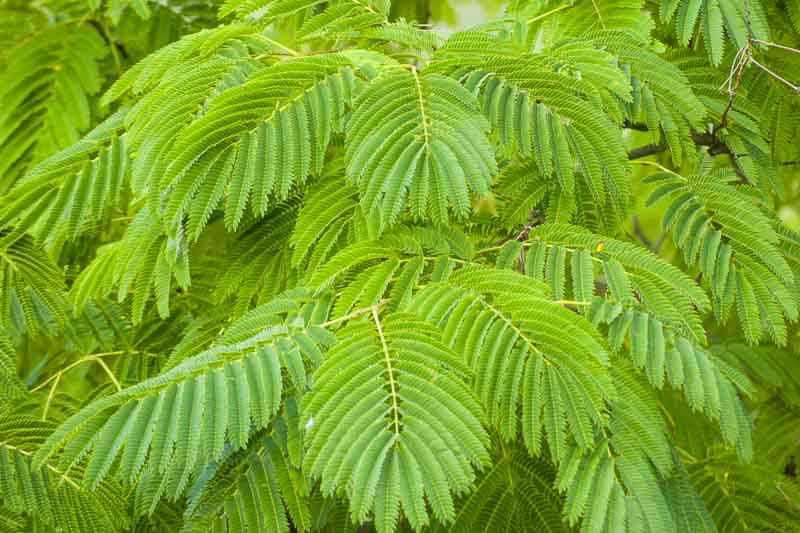Silk Tree, Mimosa Tree, Bastard Tamarind, Nemu Tree, Acacia julibrissin
The Mimosa Tree, with its exotic flowers and fern-like foliage, is a visually striking addition to landscapes. Its hardiness, wildlife benefits, and ornamental appeal make it popular in suitable climates and settings. However, its potential invasiveness and susceptibility to disease should be considered when deciding to plant it.
The Mimosa Tree, prized for its unique and striking appearance, is a fast-growing, small to medium-sized deciduous tree. It is highly recognizable for its fern-like leaves and fluffy, pink, brush-like flowers.
Native: Albizia julibrissin is native to southwestern Asia and eastern Asia. It has been widely introduced elsewhere due to its ornamental value. It is a member of the Fabaceae (legume) family, along with peas and beans.
Plant Type and Habit: This is a flowering deciduous tree with a spreading, umbrella-like canopy. It is often multi-trunked with a graceful, open form. It has a modest lifespan, averaging around 30 years, classifying it as a relatively short-lived species compared to many other trees.
Size: Typically, the Mimosa Tree grows 20-40 feet tall (6-12 meters) and 20-50 feet wide (6-15 meters), creating a broad canopy.
Flowers and Fruits: The tree is celebrated for its stunning pink, silky, filamentous flowers. These fluffy blooms are fragrant and resemble pom-poms. Flowering occurs in late spring to early summer, and the blooms last several weeks. After flowering, it produces flat, bean-like seed pods 5-7 inches long (12-17 cm), which persist into the winter.
Foliage: The leaves are bipinnate (feather-like), resembling ferns, 20 inches long (50 cm), and are a rich green, offering a delicate texture. Sensitive, the leaflets fold when touched and at night.
Bark: The bark is light brown and smooth, becoming more textured with age.
Hardiness: It’s hardy in USDA zones 6-9, tolerating a range of climatic conditions within these zones.
Uses: Primarily used as an ornamental tree due to its aesthetic appeal. It’s often planted in gardens, parks, and along streets. The Mimosa Tree is suitable for coastal gardens and Mediterranean gardens. This colorful and exotic-looking landscape tree is most attractive as a multi-stemmed tree.
Wildlife: The flowers are attractive to bees, butterflies, and hummingbirds, making it an excellent choice for pollinator gardens.
Deer and Rabbits: Generally, it is somewhat resistant to deer, though young trees may occasionally be browsed.
Drought / Salt Tolerance: Once established, the tree is moderately drought-tolerant, making it suitable for xeriscaping in warmer climates. It is also tolerant of high summer heat, humidity, and salt.
Toxicity: The seed pods and seeds contain a neurotoxin, which is toxic if ingested, so caution is advised around pets and young children.
Invasiveness: In some areas, particularly in the southeastern United States, it has become invasive, spreading into native habitats and displacing local flora. Its rapid growth, prolific seed production, and aggressive root system enable it to spread quickly and outcompete native vegetation. Find where this species is invasive in the United States. Discover beautiful U.S. native plant alternatives.


Aphids: These small, sap-sucking insects can cause leaf curling and produce a sticky residue known as honeydew, which can lead to sooty mold.
Scale insects: They appear as small, bumpy growths on stems and leaves and can cause yellowing or wilting by sucking sap.
Mimosa Webworm: This is perhaps the most common pest. The larvae create webbed nests on the branches and feed on the leaves, leading to defoliation.
Cankers: These diseases cause sunken areas on the bark and can lead to branch dieback.
Mimosa Wilt (Fusarium oxysporum): This is the most significant disease affecting Mimosa Trees. It’s a fungal infection that blocks the tree’s vascular system, causing wilting, leaf yellowing, and eventual death. Unfortunately, there is no effective treatment once a tree is infected.
Verticillium wilt: Like Mimosa Wilt, this fungal disease leads to wilting and dieback. Infected trees might exhibit one-sided death or sudden overall decline.
Brittle Wood: The tree’s wood is relatively weak, making it prone to breakage in storms or under the weight of ice and snow.
Short Lifespan: Mimosa Trees are relatively short-lived (often only 20-30 years), partly due to their disease susceptibility.
Invasiveness: In some areas, the Mimosa Tree can be invasive, spreading through its prolific seed production and aggressive root system.
Messiness: The tree can be messy, dropping flowers, pods, and leaves, which may require regular cleanup.
| Hardiness |
6 - 9 |
|---|---|
| Heat Zones |
6 - 9 |
| Climate Zones | 4, 5, 6, 7, 8, 9, 10, 11, 12, 13, 14, 15, 16, 17, 18, 19, 20, 21, 22, 23 |
| Plant Type | Trees |
| Plant Family | Leguminosae |
| Genus | Albizia |
| Common names | Mimosa, Silk Tree |
| Exposure | Full Sun |
| Season of Interest |
Summer (Early, Mid, Late) |
| Height |
20' - 40' (6.1m - 12.2m) |
| Spread |
20' - 50' (6.1m - 15.2m) |
| Maintenance | Low |
| Water Needs | Average |
| Soil Type | Chalk, Loam, Sand |
| Soil pH | Acid, Alkaline, Neutral |
| Soil Drainage | Well-Drained |
| Characteristics | Fragrant, Showy |
| Tolerance | Drought, Deer, Salt |
| Attracts | Bees, Birds, Butterflies, Hummingbirds |
| Garden Uses | Beds And Borders |
| Garden Styles | City and Courtyard, Coastal Garden, Mediterranean Garden |
| Hardiness |
6 - 9 |
|---|---|
| Heat Zones |
6 - 9 |
| Climate Zones | 4, 5, 6, 7, 8, 9, 10, 11, 12, 13, 14, 15, 16, 17, 18, 19, 20, 21, 22, 23 |
| Plant Type | Trees |
| Plant Family | Leguminosae |
| Genus | Albizia |
| Common names | Mimosa, Silk Tree |
| Exposure | Full Sun |
| Season of Interest |
Summer (Early, Mid, Late) |
| Height |
20' - 40' (6.1m - 12.2m) |
| Spread |
20' - 50' (6.1m - 15.2m) |
| Maintenance | Low |
| Water Needs | Average |
| Soil Type | Chalk, Loam, Sand |
| Soil pH | Acid, Alkaline, Neutral |
| Soil Drainage | Well-Drained |
| Characteristics | Fragrant, Showy |
| Tolerance | Drought, Deer, Salt |
| Attracts | Bees, Birds, Butterflies, Hummingbirds |
| Garden Uses | Beds And Borders |
| Garden Styles | City and Courtyard, Coastal Garden, Mediterranean Garden |
How many Albizia julibrissin (Mimosa Tree) do I need for my garden?
| Plant | Quantity | |
|---|---|---|
| Albizia julibrissin (Mimosa Tree) | N/A | Buy Plants |
Create a membership account to save your garden designs and to view them on any device.
Becoming a contributing member of Gardenia is easy and can be done in just a few minutes. If you provide us with your name, email address and the payment of a modest $25 annual membership fee, you will become a full member, enabling you to design and save up to 25 of your garden design ideas.
Join now and start creating your dream garden!
Create a membership account to save your garden designs and to view them on any device.
Becoming a contributing member of Gardenia is easy and can be done in just a few minutes. If you provide us with your name, email address and the payment of a modest $25 annual membership fee, you will become a full member, enabling you to design and save up to 25 of your garden design ideas.
Join now and start creating your dream garden!